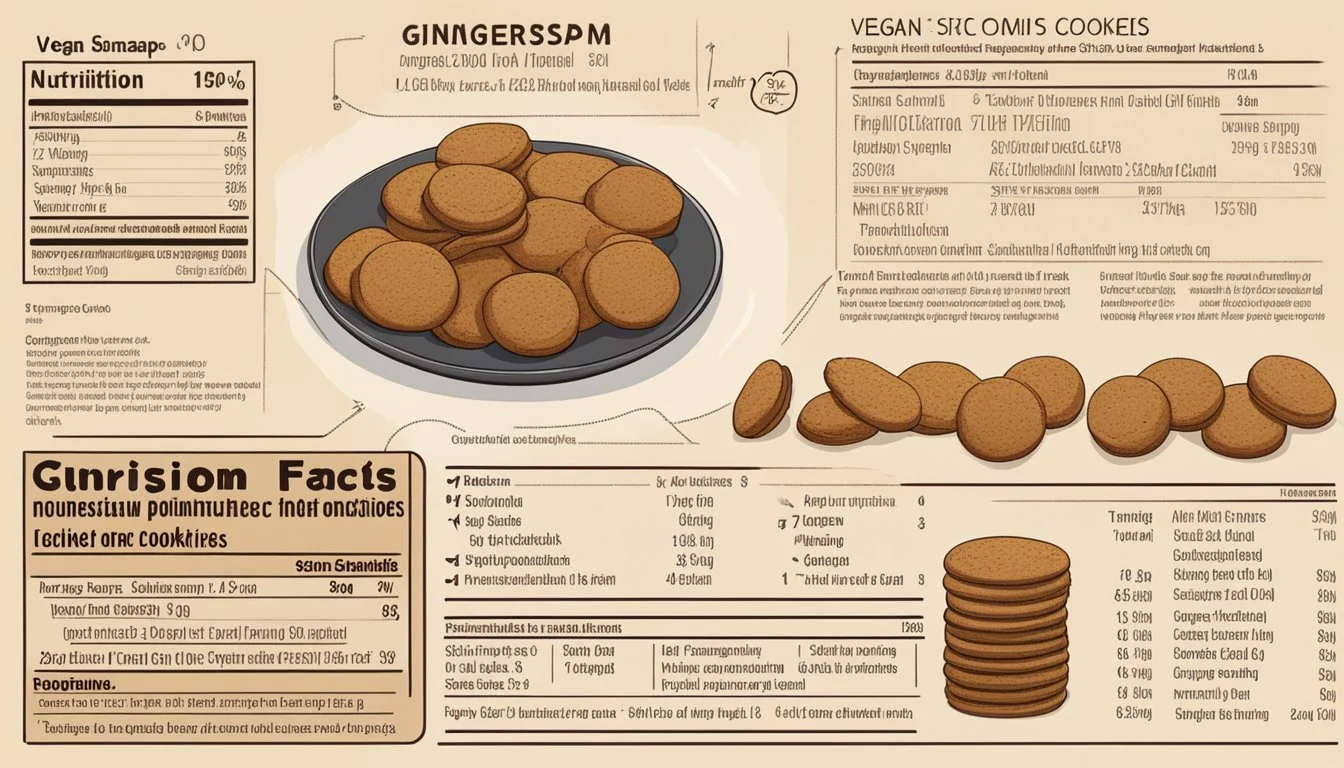Are Gingersnap Cookies Vegan?
Unveiling the Ingredients
Gingersnap cookies are a classic treat, defined by their rich spices, snappy texture, and a depth of flavor often achieved with molasses. Traditionally, gingersnaps might not align with vegan dietary restrictions as they can contain butter, eggs, and other animal products. Veganism excludes all forms of animal exploitation and cruelty, whether for food, clothing, or any other purpose. Therefore, vegans avoid traditional gingersnap cookies that include ingredients derived from animals.
However, that does not mean gingersnap cookies are off the menu for those following a vegan lifestyle. Many recipes and commercial options for vegan gingersnap cookies are available, utilizing plant-based substitutes. Vegan bakers may use ingredients like vegan butter, non-dairy milk, flaxseed as an egg substitute, and syrups to replace honey or other non-vegan sweeteners. These vegan versions aim to retain the beloved gingery kick and comforting sweetness, all while adhering to vegan principles.
The availability of vegan gingersnap cookies has increased with the rising popularity of veganism. Individuals interested in plant-based diets can now enjoy vegan gingersnap cookies without compromising on taste or texture. As recipes continue to evolve, vegan gingersnap cookies are becoming more indistinguishable from their non-vegan counterparts, offering a cruelty-free alternative to this spicy, sweet delight.
Understanding Veganism
In the realm of culinary arts, veganism adheres to a philosophy of plant-based ingredients, omitting all animal-derived products. This section explores the specifics of what constitutes a vegan product, especially in baking where traditional recipes often call for animal-derived ingredients.
Defining Vegan Products
Vegan products are strictly derived from non-animal sources. They exclude meat, dairy, eggs, and honey, which are staples in many diets. Instead, they focus on plant-based alternatives that are cultivated and processed without animal involvement. When assessing the vegan status of a product, one must ensure that every ingredient complies with this standard.
Vegan Certification Labels help consumers identify products that have been verified as vegan. These items have undergone evaluation to ensure they meet strict vegan standards, ensuring no cross-contamination with animal-based ingredients during production.
Vegan Baking Essentials
Vegan baking has its unique set of essentials to replace commonly used animal-derived ingredients. Below is a brief overview of key vegan substitutes used in baking:
Non-Vegan Ingredient Vegan Substitutes Butter Vegan butter, plant-based butters, coconut oil Eggs Flax meal, commercially available vegan egg-replacers Chocolate Vegan chocolate (without dairy additives) Sugar Unrefined granulated sugar, organic sugar not processed with animal bone char Milk Plant-based milks (almond, soy, oat, etc.)
Vegan butter and plant-based butters are critical in vegan baking, offering the same creamy texture and fat content necessary for baked goods without using dairy. Coconut oil is another favorite, often used for its stable properties and subtle flavor profile. All-purpose flour remains a staple in vegan baking as it does not contain any animal products.
Flax meal is a common egg substitute, as it gels when mixed with water and can mimic an egg's binding properties in recipes. Vegan chocolate is made without dairy, allowing for indulgent desserts without animal exploitation. Unrefined granulated sugar ensures sweetness without the use of bone char, which is present in the refining process of some sugars.
Bakers must pay close attention to ingredient labels and opt for products that align with vegan ethics, including the sourcing and manufacturing processes. With a clear understanding of vegan products and the essentials of vegan baking, consumers and culinary enthusiasts can navigate this compassionate and sustainable way of eating with confidence.
Ingredients Analysis
When assessing whether gingersnap cookies are vegan, one must carefully evaluate the ingredients list. Traditional gingersnap cookies may contain animal-derived ingredients, but there are vegan alternatives for every component.
Common Ingredients in Gingersnap Cookies
Flour: Typically all-purpose flour forms the base of the cookie dough.
Sugar: Granulated sugar adds sweetness and is often used to coat the cookies before baking.
Molasses: Gives the cookies their classic rich, dark flavor.
Ginger: Ground ginger is a critical spice that characterizes gingersnap cookies.
Cinnamon & Cloves: These spices compliment the ginger and contribute to the cookie's warm flavor profile.
Butter: Often used in non-vegan recipes to create a rich, tender texture.
Leavening agents: Baking soda and powder are common leavening ingredients that help the cookies rise.
Vegan Substitutes for Traditional Ingredients
Vegan Butter: Can replace dairy butter to provide a similar rich texture without using animal products.
Sugar: Some sugars are processed with bone char, so ensuring the sugar is organic or labelled vegan is important.
Flour: While typical recipes use all-purpose flour, one can also use all-purpose gluten-free flour for gluten sensitivities.
Applesauce & Maple Syrup: Can be used as alternatives to eggs and molasses in some recipes to bind ingredients and add sweetness.
Oat Flour: An alternative flour option for those seeking gluten-free or whole grain variations.
By substituting animal-derived ingredients like butter with vegan butter, and choosing bone char-free sugars, one can craft a delicious vegan gingersnap cookie that adheres to plant-based dietary standards. The judicious choice of ingredients ensures that the integrity of the gingersnap's desired qualities—crispiness, spiciness, and a robust molasses-flavored undertone—is preserved.
Recipe and Preparation
When making vegan gingersnap cookies, the recipe and preparation are key for achieving the right balance of flavors and textures. Vegan alternatives must be used in place of traditional ingredients to ensure the cookies adhere to vegan standards.
Vegan Gingersnap Cookie Recipe
A vegan gingersnap cookie recipe typically features a mixture of flour, baking soda, salt, and a blend of spices including cinnamon, ginger, and allspice. Vegan butter is creamed with brown sugar until fluffy, to which molasses is often added for depth of flavor. It's important to substitute any non-vegan ingredients like dairy butter with vegan alternatives, such as plant-based butter. The dry ingredients are then gradually mixed into the wet ingredients to form a coherent dough.
Ingredients for dough:
All-purpose flour
Baking soda
Salt
Ground ginger
Ground cinnamon
Allspice
Vegan butter
Brown sugar
Molasses
Utensils and tools needed:
Mixing bowls
Mixer or whisk
Cookie scoop
Baking sheets lined with parchment paper
Baking Instructions and Tips
Preheat the oven to approximately 350°F (180°C). While the oven is heating, the dough should be chilled for at least 30 minutes to firm up, which makes it easier to handle and helps prevent spreading too much during baking. Use a cookie scoop to portion the dough onto a baking sheet, then use the flat bottom of a glass to slightly flatten each ball of dough, ensuring uniform cookies.
Baking steps:
Chill the dough for 30 minutes.
Scoop and place dough balls on the baking sheet.
Flatten each ball.
Bake in the preheated oven for about 10-15 minutes or until the edges are firm and the cookies are just beginning to crack.
Tips:
Monitor the cookies closely as baking times may vary based on size.
Let the cookies cool on the baking sheet for a few minutes before transferring to a wire rack. This allows them to firm up and become easier to handle.
By carefully following this recipe and baking instructions, one can make delicious vegan gingersnap cookies with a characteristic snap and richly spiced flavor.
Nutritional Information
In assessing the nutritional profile of vegan gingersnap cookies, one should consider both macro and micronutrient content. These cookies are typically rich in carbohydrates and can vary in protein and fat content based on the ingredients used.
Calorie and Macro Breakdown
Nutrient Amount per cookie (approx.) Calories 80-120 Carbohydrates 15-20g Protein 1-2g Fat 3-5g Saturated Fat 0.5-1g Fiber 0.5-1g
The calories in vegan gingersnap cookies primarily come from carbohydrates, which is the primary source of energy. The protein content is low, while fat content may vary depending on the types of oils or fats used in the recipe.
Micronutrients Found in Vegan Cookies
Vegan gingersnap cookies are not typically known for being micronutrient-dense, but they do contain some iron and fiber due to the use of whole-grain flours and molasses. The contents of micronutrients like iron and sodium also depend on the specific ingredients used.
Iron: The molasses in some vegan cookie recipes is a source of iron.
Sodium: There is generally a small amount of sodium present due to added salt for flavoring.
These cookies should be enjoyed as part of a balanced diet, giving consideration to their placement within daily caloric and nutritional needs.
Texture and Flavor Profiles
Traditional gingersnap cookies are known for their distinctive snap and rich blend of spices. This section explores the critical elements involved in achieving the hallmark texture and flavor of vegan gingersnap cookies.
Achieving the Perfect Snap
The texture of a gingersnap is paramount; it should be crisply crunchy yet not too hard. The snap comes from the precise balance of ingredients and baking time. Key to this is the use of brown sugar, which contributes to the cookie's firmness along with properly measured baking soda. To ensure a crunchy texture, the cookie dough should be rolled thin before cutting and baking. Overbaking slightly can also help produce that characteristic snap when cooled. What's more, a chewy center can be obtained by slightly underbaking the cookies, allowing for a crisp edge with a softer middle.
Ingredients for snap:
Brown sugar
Baking soda
Thinner dough rolling
Baking tips:
Longer baking time for a crispier cookie
Shorter baking time for a chewy center
Balancing Spice and Sweetness
The flavors in vegan gingersnap cookies come from a robust combination of spices and sweetness. Ground ginger, ground cinnamon, and ground cloves are the pillars that provide the warm and spicy notes. The amount of each spice can be adjusted to cater to one's taste—more ginger for a spicier kick, or a bit more cinnamon for a gentle warmth. The spices are balanced with the sweetness of brown sugar and the rich, deep flavor of molasses or a vegan alternative, which also contributes to the moistness of the cookie. A hint of vanilla extract can round out the flavors subtly, creating a complex flavor profile that is both comforting and pleasantly sharp.
Spice blend for flavor:
Ground ginger
Ground cinnamon
Ground cloves
Sweetness and depth:
Brown sugar
Molasses or vegan alternative
Vanilla extract
In crafting the perfect vegan gingersnap cookie, attention to texture and flavor creates a delightful experience of a classic treat.
Storing and Preservation
Proper storage is crucial to maintaining the freshness and quality of gingersnap cookies. Whether one opts to keep them at room temperature or freeze them for later use, understanding the best methods will ensure that the cookies remain delicious for as long as possible.
Best Practices for Freshness
To keep gingersnap cookies fresh at room temperature, they should be stored in an airtight container. The container limits exposure to air, preventing the cookies from becoming stale. Additionally, storing them in a cool, dry place away from direct sunlight helps to maintain their crisp texture. Adhering to these practices typically allows the cookies to stay fresh for up to a week.
Room Temperature Storage: Typically up to 1 week for optimal freshness.
Container: Utilize an airtight container for best results.
Location: Store in a cool, dry place out of direct sunlight.
Freezing and Thawing Methods
For longer storage, gingersnap cookies can be frozen. To freeze, one should ensure that the cookies are placed in an airtight container or a heavy-duty freezer bag to prevent freezer burn. Cookies can be stored in the freezer for up to 3 months. When ready to serve, simply thaw the cookies at room temperature for a few hours before consumption, which will help to retain their original flavor and texture.
Freezing: Place in an airtight container or heavy-duty freezer bag.
Duration: Can be frozen for up to 3 months.
Thawing: Leave at room temperature for a few hours before serving.
Alternative Variations
When adapting gingersnap cookies to cater to different dietary requirements or to introduce new flavors, there are numerous approaches one can take. These variations ensure that the beloved spicy sweetness of gingersnap cookies can be enjoyed in a form suited to various preferences and needs.
Gluten-Free and Allergy-Friendly Options
For individuals with gluten sensitivity, traditional all-purpose flour can be replaced with a gluten-free flour blend to make vegan gingersnaps. It’s important to ensure that the gluten-free blend used mimics the properties of wheat-based flour for desired texture. Some recipes may also call for xanthan gum, which helps to bind the ingredients together in the absence of gluten. When it comes to other common allergens, dairy and egg substitutions are already taken care of in vegan recipes with the use of ingredients like plant-based butter and flaxseed as binding agents. One has to be mindful of potential cross-contaminants and read labels carefully when purchasing ingredients, particularly in the case of nuts.
Innovative Vegan Gingersnap Flavors
Innovative variations of vegan ginger cookies can include a mixture of spices such as cinnamon, ground ginger, cloves, and allspice, which are typical for classic gingersnaps. Fresh ginger can add a more potent flavor compared to the powdered form. For those looking to add a twist, incorporating vegan chocolate either in chunks or as a drizzle can complement the spicy profile of the cookies. Some bakers may also experiment with gingerbread-inspired spices or add crystallized ginger pieces for an extra textural element. These additions can be carefully balanced to enhance the overall flavor of the cookies without overpowering the characteristic ginger snap taste.
Occasions and Serving Ideas
Gingersnap cookies, with their rich holiday spices, make a delightful addition to festivities. They excel not only in taste but also in versatility, suitable for various celebratory contexts.
Incorporating into Holiday Celebrations
During the holiday season, gingersnaps are a staple. They can proudly take their place on a Christmas cookie platter, accompanying other classics such as sugar cookies and shortbread. One will often find these cookies tagged as #ChristmasCookies on Instagram, where they shine as a popular item in holiday baking showcases.
Holiday Spices: Their robust flavor profile, featuring spices like cinnamon and ginger, embodies the essence of holiday baking.
Aromatic Decor: Their sturdy texture makes them ideal for hanging as edible decorations on a Christmas tree.
Creative Ways to Serve Gingersnaps
Gingersnaps can be more than just a holiday cookie. They offer an array of serving possibilities:
With Ice Cream: Crumble them atop a scoop of vegan vanilla ice cream for a textural contrast.
As a Pie Crust: Crushed gingersnaps can form a spicy, crunchy base for a festive pie or cheesecake.
Layered Desserts: Incorporate gingersnap pieces into a trifle or parfait to add a spiced, crunchy layer.
Whether integrated into traditional holiday celebrations or served up with a twist, gingersnaps offer a unique and flavorful experience suited for any occasion.
Frequently Asked Questions
In this section, users find answers to common queries regarding vegan gingersnap cookies and receive guidance to navigate the world of vegan baking with confidence.
Addressing Common Concerns
Are gingersnap cookies inherently vegan? Traditionally, gingersnap cookies are not vegan, as they may contain ingredients like butter, eggs, or honey. However, with the appropriate substitutions, one can easily make a comforting batch of vegan gingersnap cookies.
What are common substitutes for non-vegan ingredients? Bakers frequently replace butter with vegan butter or oils and use plant-based milks instead of dairy. For sweeteners, molasses or maple syrup can serve as excellent vegan-friendly alternatives to honey.
Can I find vegan gingersnap ingredients at a grocery store? Yes, most grocery stores carry the ingredients required for vegan baking. These include flour, baking soda, vegan butter, and spices like ginger and cinnamon.
Tips for First-Time Vegan Bakers
How do I ensure my gingersnap cookies are fully vegan? It's important for first-time vegan bakers to meticulously check ingredient labels when shopping, as some products may have unexpected animal-derived components.
Is a vegan gingersnap recipe easy to make? Vegan recipes often emphasize simplicity, with many gingersnap cookie recipes designed to be made in one bowl, reducing kitchen cleanup and making the process straightforward.
What are the basic measurements for a vegan gingersnap recipe? While measurements can vary, a good starting point for a simple batch includes combining 1 cup of flour, 1 teaspoon of ground ginger, and 1/2 teaspoon each of baking soda and cinnamon, among other ingredients, before mixing in the wet components.
Bakers are encouraged to approach vegan baking with curiosity and patience, embracing it as an opportunity to explore a range of flavorful and compassionate choices in the kitchen.









